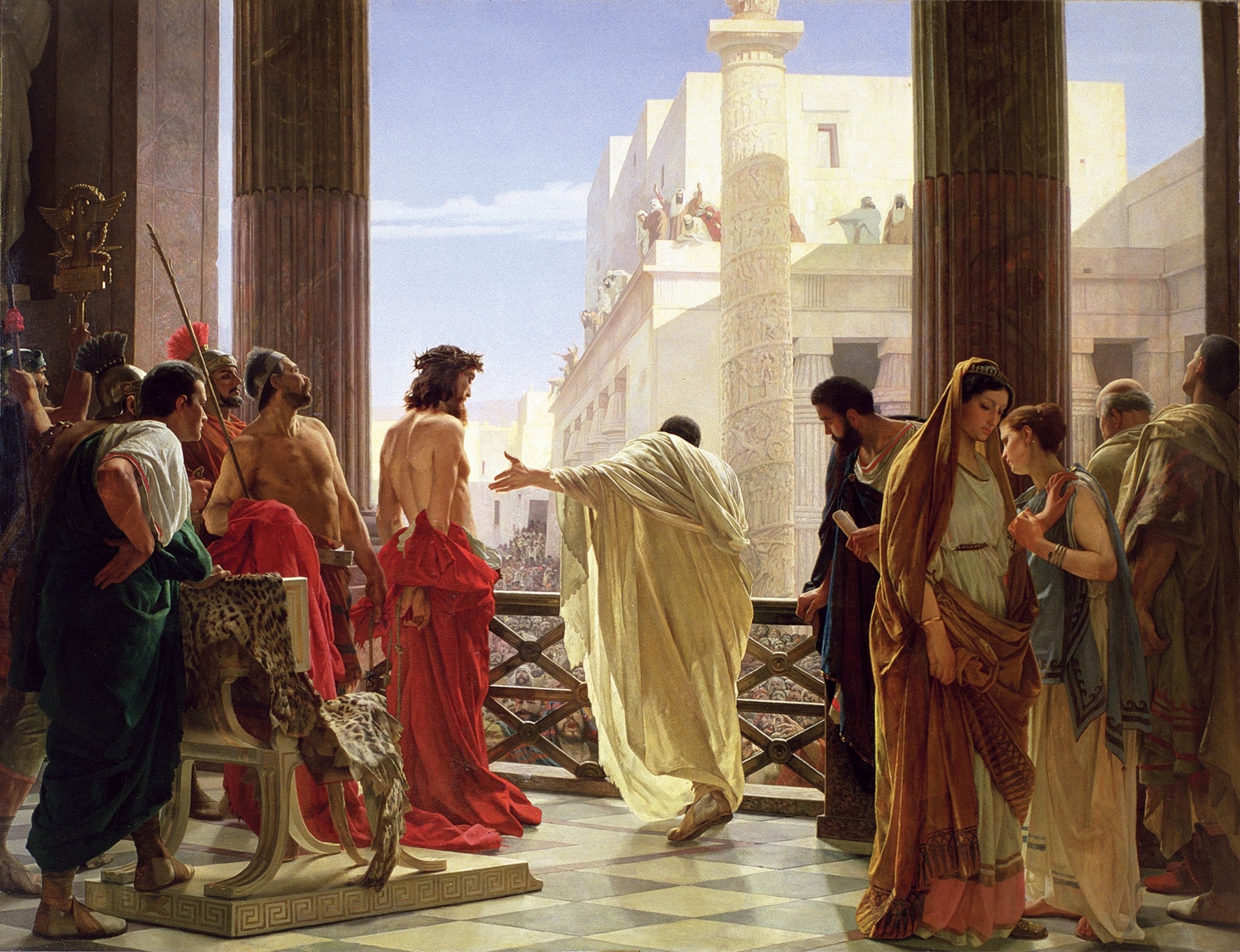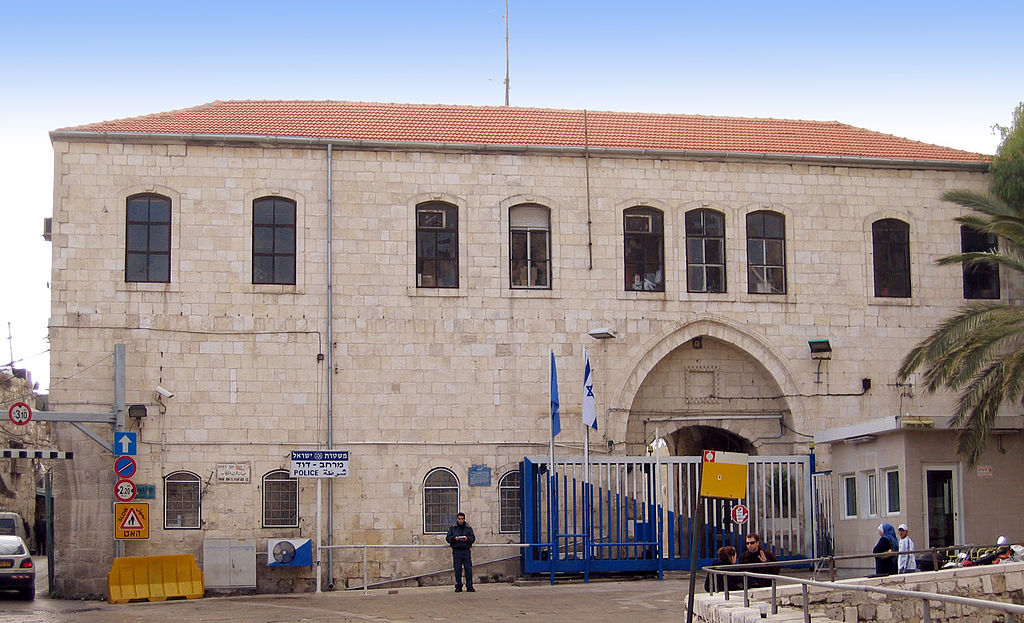
Antonio Ciseri’s depiction of Ecce Homo, 1871.
The location of the trial of Jesus by Pontius Pilate is one of the most debated subjects in the field of Jerusalem’s historical geography. For over 1500 years Christian pilgrims have followed in the footsteps of Jesus, walking a devotional route known as the “Way of the Cross” from the site of the condemnation of Jesus to the site of his crucifixion. The route as well as the number stations has changed significantly over the ages, as described here by Jerome Murphy O’Connor. The well-known modern-day route known as the the Via Dolorosa (Latin, “Way of Pain”) containing fourteen stations was established in the 1700s by Franciscan monks. In this post I would like to explore one of the famous sites that appears along this route. Between Stations 2 (the flagellation) and 3 (the first fall) one comes across a Roman archway that spans the street.
This is known as the Ecce Homo arch and is purported to be the site where Pilate handed Jesus over to the crowd, uttering “here is the man!” (John 19:5). There are two problems with this tradition. The first is linguistic and has to do with its name. Ecce Homo means “here is the man” in Latin. While it is certainly true that Roman appointed prefects like Pontius Pilate spoke Latin among themselves, the language they would have used in the eastern provinces such as Judaea was Greek. Latin was the language of the western provinces of the Roman Empire (e.g., Gaul, Britannia, Africa). In the eastern provinces (e.g., Syria, Egypt, Asia), by contrast, Latin was only used in official imperial inscriptions (milestones, dedications, etc) and in written correspondence with the imperial authorities back in Rome.

A column in an alley near the Jaffa Gate containing a 3rd century Latin inscription: M(arco) Iunio Maximo leg(ato) Aug(ustorum) Leg(ionis) X Fr(etensis) Dom(itius) Serg(ius) Jul (ius ) Honoratus. Str (atores) eiu{s}.
When a Roman governor addressed a crowd of Jews (who had gathered from all over the Mediterranean region) in Jerusalem, Greek would have certainly been the default tongue. This situation is somewhat analogous to a Norwegian UN peacekeeping soldier in Mali today speaking English with the locals rather than his own native tongue (Norwegian) or the official language of the country (French). It is assumed today that everyone around the world knows at least bit of English; the same would have been true across the Roman Empire in the first century.
According to the Gospel of John, the phrase that Pilate really did utter was: ἴδε ὁ ἄνθρωπος (ide ho anthropos), which literally means “look at the human being”. This is quite different than the Latin phrase ecce homo which simply means “here is the man”. The first Greek word (ἴδε) is an imperative aorist of the verb εἴδω, “to see, to look at, to perceive”. It is etymologically connected with the Latin verb video, which means the same thing. Ecce, on the other hand, does not necessarily imply seeing, although most dictionaries translate it as “behold”. It is referential and directional, but it is not a verb at all! Etymologically, it is derived from the words ec (“this one”) and ce (“here on this side”). This is an important distinction. Pilate is not merely handing over Jesus to be crucified, telling them “fine, here he is”. He wants the mob to actually visually observe Jesus and understand the gravity of what they are asking him to do. The emphasis in the original Greek is clearly aesthetic.
The second Greek word uttered by Pilate is ἄνθρωπος (anthropos). This is not merely “man” for which there is another Greek word: ἀνήρ (aner), meaning an adult male or husband. Instead, anthropos means “human being”, which is the same for the Latin word homo. Pilate again wants to draw the attention of the crowd to the gravity of what they are asking him to do: “he is alive now, and you are asking me to end his life. Are you sure?” The emphasis is on the humanity of Jesus rather than on his masculinity.
The second problem with the Ecce Homo arch concerns its location. This relates to matters of historical dating and the geography of Jerusalem in the first century CE. Quite simply, this arch could not have been the location where Pilate uttered these words because it was not yet built at the time. The arch dates to about 100 years after Jesus was in Jerusalem for the Passover festival of 30 CE. It is part of a large triumphal arch built by the Emperor Hadrian to commemorate his victory over the Bar Kokhba Revolt in 135 CE. The triple-arched structure was a gateway into the eastern forum of Jerusalem. It marked the beginning of the city’s main east-west street called the Decumanus. Building this arch was part of Hadrian’s total overhaul of the city, which he drastically rebuilt and renamed Aelia Capitolina. Much of the network of streets in the Old City of Jerusalem today is a vestige of the Hadrianic reconstruction of the city. Originally the triumphal arch was a freestanding structure containing three arches: one large central arch flanked by two smaller arches. This is identical to other Roman triumphal arches, such as the Arch of Constantine in Rome seen here.

The Arch of Constantine, located adjacent to the Colosseum in Rome. It was built by the emperor Constantine in 315 CE to commemorate his victory at the Battle of the Milvian Bridge three years earlier.
But this is no longer the case in modern-day Jerusalem. Today the Hadrianic triumphal arch has become absorbed into the architecture of the surrounding Muslim Quarter. The largest central arch still spans the east-west street known today as the Via Dolorosa.

A photo of the Ecce Homo arch taken between 1890 and 1900. The slender steeple of St Savior’s can be seen in the distance beneath the arch.
But the smaller southern (right) arch is no longer extant. The smaller northern (left) arch is inside an adjacent building where it serves as the nave for a small Catholic chapel.

A Roman Catholic chapel known as the Ecce Homo Church built around the smaller northern Hadrianic arch. The larger central arch which spans the street outside is located to the right of this photo.
To complicate matters even further, scholars today have cast serious doubts on the historicity of the route of the Via Dolorosa. As mentioned above, the current route containing fourteen stations is not particularly ancient. This route begins at the northern edge of the Temple Mount and winds southwest through the Muslim Quarter, ending at the site of the crucifixion within the Church of the Holy Sepulchre. This route is predicated on the assumption that Pilate’s residence (which the Gospels refer to as the praetorium) in Jerusalem was located inside the Antonia Fortress, a Roman police station overlooking the Temple. It was entirely destroyed along with the Temple in the course of Great Revolt of 66-73 CE.

A model of the Antonia Fortress overlooking the courtyard of the Herodian Temple (at the Israel Museum). In the background you can see the western walls of city, outside of which the Rock of Golgotha was located.

A view of the same model from the opposite direction. The Rock of Golgotha is in the foreground, the Antonia Fortress is in the background
Modern-day scholars think it is more likely that when Pilate (who normally resided on the Mediterranean coast in the provincial capital city of Caesarea Maritima) came to Jerusalem, he would have resided in the old palace of King Herod, located near the Citadel (“Tower of David”) overlooking the Kidron Valley, near today’s Jaffa Gate.
For centuries the Antonia police station was thought to be the site of Pilate’s palace. Ironically, the site of Herod’s palace has become a police station, still known today as the “Kishle” (a vestige from the Ottoman period). Impressive remains of this palace have been uncovered beneath the police station and were recently opened up for public viewing.

Archaeological excavations beneath the Kishle police station inside the Jaffa Gate have revealed remains from all of the city’s numerous historical periods.
What all of this means is that most likely Jesus was tried by Pilate somewhere near the Citadel. There is no Ecce Homo arch here because the structure was entirely razed to the ground during the Roman destruction of the city in 70 CE. But because this site located upon the summit of Jerusalem’s western hill (known as the “Upper City“), this is the most elevated part of the Old City. The topography perhaps explains the real meaning of the following verse:
When Pilate heard these words, he brought Jesus outside and sat on the judge’s bench at a place called the Stone Pavement, or in Hebrew Gabbatha. (John 19:13)
There are two problems here. First, the word Gabbatha is not Hebrew but Aramaic. That is not a major problem since the Gospel of John elsewhere uses Hebrew to refer to the spoken language of the Jews in first century Judea (John 19:20). The second problem is more serious. The word Gabbatha does not really mean “stone pavement” (which the Greek lithostroton does mean), but “high place” from the Semitic root גבה which means “high, elevated”. Although this theory is not accepted by everyone, the palace of Herod seems a much better option than the Antonia Fortress for the site of the trial of Jesus.

The Ottoman era “Kishleh” police station located near the Jaffa Gate. Excavations beneath this building have revealed impressive remains of the palace of Herod the Great. This is the most likely location for where Jesus was tried by Pilate.







Join the conversation (No comments yet)